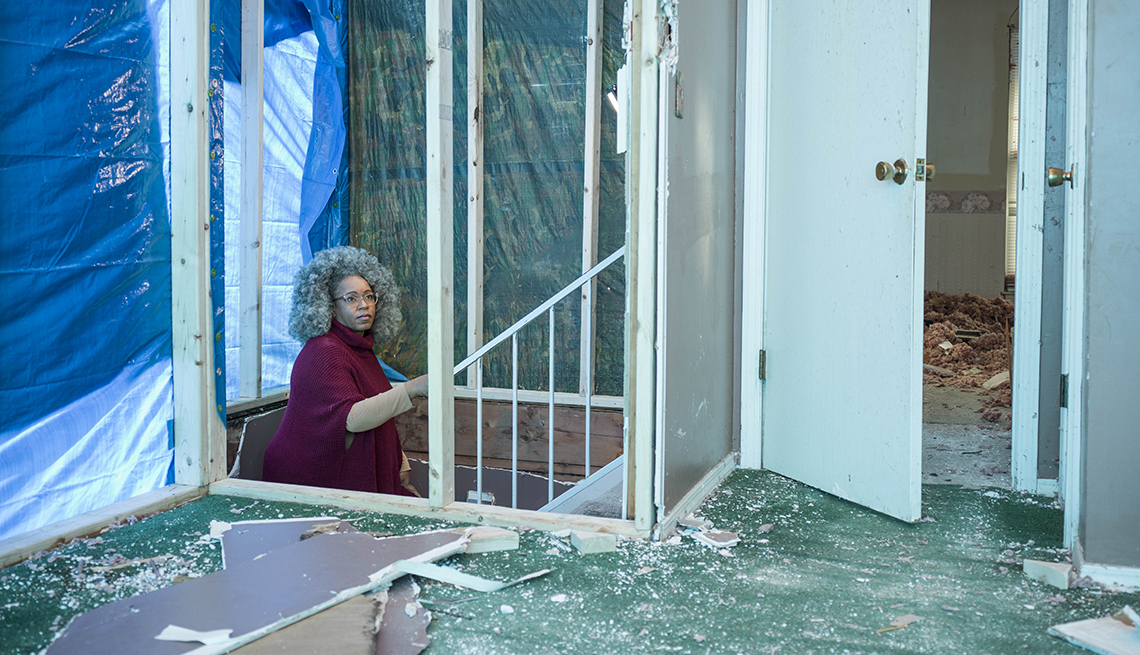AARP Eye Center
Danger Zone: How to Prepare for Natural Disasters
Tonya Osborne left her home early for a photo shoot last December because she didn’t want to be driving in a powerful storm barreling toward her suburban Nashville home.
By the time the 54-year-old photographer and AARP member got back to her Madison neighborhood, a tornado from the storm had severely damaged her house. “That was when I realized, Wow, for the first time, I am homeless,” she says. She had lived there 23 years.
As natural disasters pummel the state, AARP Tennessee is working with the Red Cross to help older residents prepare for — and recover from — Mother Nature’s wrath. In addition to hosting a telephone town hall, the organizations are sharing vital supplies in a storm’s aftermath and resources to get ready for the next one.
Unfortunately, the need to help Tennesseans is a growing reality.
In March 2020, for example, deadly tornadoes tore across Middle Tennessee, killing more than 20 people and prompting AARP Tennessee’s initial decision to team up with the Red Cross. Since then, the state has continued to face numerous other threats, from ice storms to extreme heat, floods to drought.

The number of tornadoes fluctuates from year to year, but they’ve been trending upward over the past several decades, according to National Weather Service data. “In the past 20 years, we’ve seen a lot more tornadoes occurring around the mid-south region,” says Sam Herron, a meteorologist with the weather service in Nashville. “And a lot of the tornadoes have been deadly.”
In fact, what was once considered Tornado Alley — states such as Kansas, Nebraska, Oklahoma and parts of Texas — has expanded, putting parts of Tennessee, Kentucky, Alabama and Mississippi in the new danger zone, according to Scientific American.
AARP, Red Cross step in
After the December 2023 tornado that tore through Osborne’s neighborhood — one of seven that killed seven people and caused catastrophic damage in multiple counties that day — both AARP and the Red Cross sprang into action. The Red Cross set up shelters and provided supplies and food, says Sarah Breazeale, executive director of the American Red Cross of Mid-South Tennessee. The organization is also working to provide financial assistance to some who lost their homes.
AARP Tennessee donated supplies, including generators, propane, extension cords, cots and nonperishable foods, to relief organizations, says Rob Naylor, its communications director. AARP also sent email blasts and made social media posts with information on how members could help.
As for the next storm? You can’t predict when disaster will come. But here are some ways to be prepared if it does:
- Join a telephone town hall hosted by AARP Tennessee and the Red Cross, set for Thursday, March 21, at 10 a.m. CT. It will focus on emergency preparedness and springtime natural disaster threats and feature the Red Cross’ Breazeale and AARP Tennessee State Director Mia McNeil. The audio call will be livestreamed at facebook.com/AARPTennessee.
- Prepare an emergency kit in case you need to leave immediately or are stuck in your home for several days. Have enough food, medicine and supplies for family and pets, says Breazeale. Find more tips at ready.gov.
- Set an emergency communications plan. Breazeale advises residents to have a contact person — a neighbor, friend or family member — to check in with in the event of an emergency. While everyone has to plan for the worst, she says, some older people have unique needs in an emergency.
As for Osborne, she feels blessed to be alive but is also beset by a sense of loss. “When ... your life is relegated to five or six black garbage bags, it’s overwhelming,” she says.
At press time, she was in temporary housing, waiting for insurance to come through.
Sheila Burke, a freelance writer in Nashville, has written for the AARP Bulletin for more than 10 years.
More on disaster preparation

































































